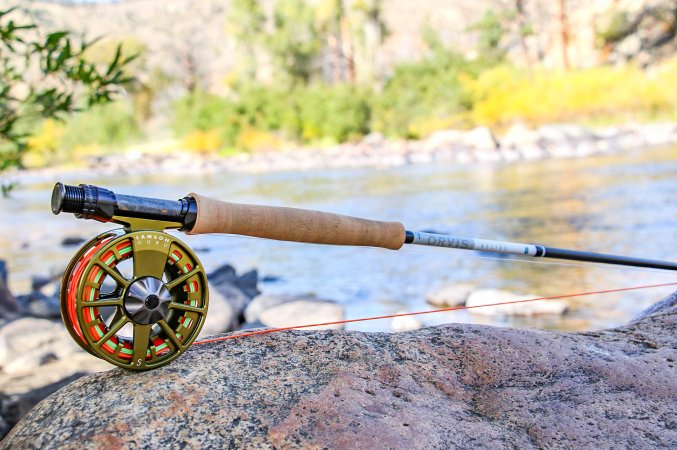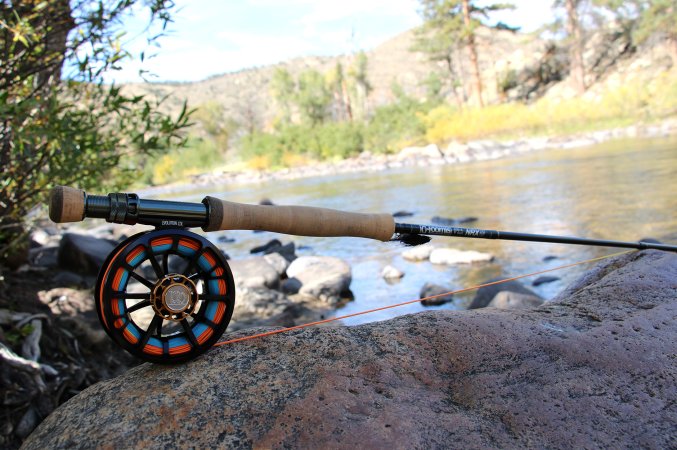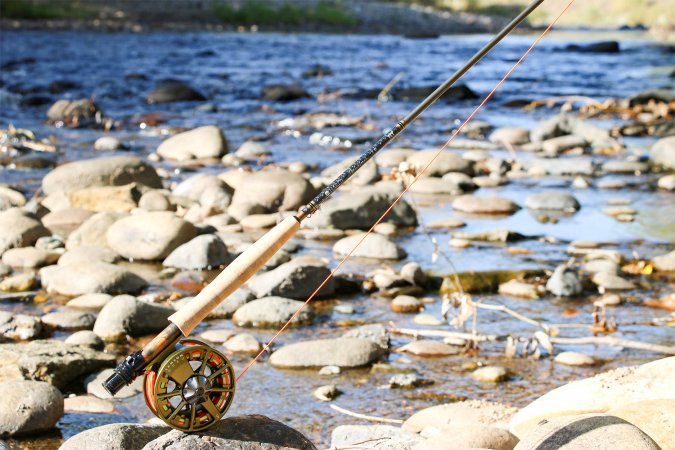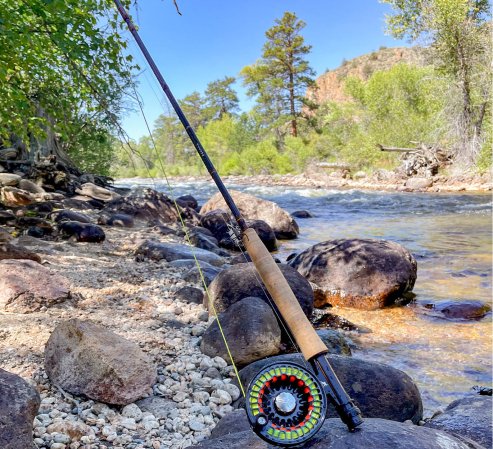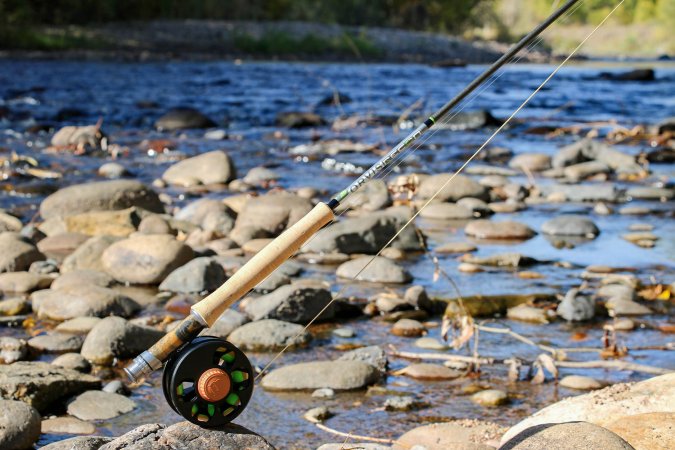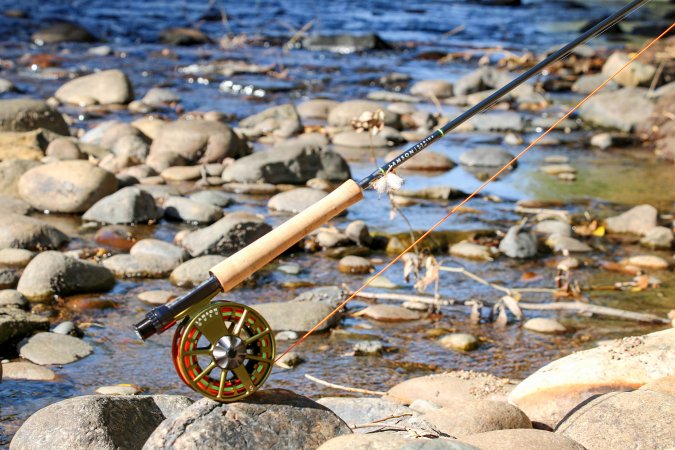We may earn revenue from the products available on this page and participate in affiliate programs. Learn More ›
The modern-day trout angler has a vast array of fly rods to choose from. As someone who’s spent far too much time in fly shops looking at and thinking about all these options, I understand how difficult shopping for a new rod can be.
So, I’ve tried to remove some of the guesswork by selecting 12 of what I consider to be the best fly rods for trout. These are all fly rods that I sought out specifically and then put through the paces this spring, summer, and early fall. I casted these rods head-to-head and then fished with them on a variety of different waters under varying conditions.
There is, of course, some subjectivity involved with this review. Fly anglers are an opinionated bunch, and the single “best” fly rod for trout will differ from one person to the next depending on their budget, skillset, and the style of fishing they like to do. And because it was physically impossible for me to get my hands on every fly rod under the sun, there are some rods that didn’t make the list that are still very fine trout tools.
The list below includes a variety of different rods that will cover your bases on any trout stream or lake in North America, with a few exceptions (that we’ll get to in a minute). Some of these options are more all-arounders, while others are specialty rods, and I’ve included several top-tier models along with some budget options. Think of this list as a starting point. And if you can, always try a rod yourself before you commit to buying it.
- Editor’s Choice: Scott Centric 905
- Best Budget: Redington Classic Trout 763
- Best for Dry Flies and Delicate Presentations: Thomas & Thomas Paradigm 844
- Best for Float Fishing and Nymphing: Orvis Helios 955-D
- Best for the Backcountry: Douglas Upstream 763
- Best for Streamer Fishing: G Loomis NRX+ 906
- Hardy Marksman 905
- Scott G Series 884
- Douglas DXF Gen2 905
- Orvis Recon 905
- Lamson Radius 905
- Beulah Guide Series II 905
How I Tested the Best Fly Rods for Trout

I’m an advanced fly caster and a former fly-fishing guide. I live in northern Colorado, where I’m surrounded by more trout water than I could ever fish in a lifetime. I’m within striking distance of several freestone streams, countless high-elevation creeks and alpine lakes, along with some of the West’s most famous (and crowded) tailwaters.
The Casting Test
My testing procedure involved a casting test in an open field. To test for accuracy, I placed three 20-inch by 20-inch targets at distances of 20, 45, and 60 feet. Using a single dry fly, I cast each rod at each target three times, marking the number of times the fly landed within the target. A perfect score would be a 9 out of 9.
To test for distance, I made five attempts with each rod to cast as far as I possibly could. I marked down only the farthest distance but took consistency into consideration.
I judged the “castability” of these rods while performing both tests, giving each rod a score from 1 to 5 based on how easy it was to cast. This category is a little more subjective than the previous two, because a lot of it has to do with the “feel” of the rod, which can change from one caster to the next.
I used Scientific Anglers floating fly lines, and I tried a couple different tapers with each rod. I found that most rods paired well with SA’s Amplitude Smooth Infinity taper, but there were a few exceptions. (I note recommended fly line pairings in the test results section for each product.) For terminal tackle, I used a Scientific Anglers Absolute Trout 9-foot, 3X tapered leader and a size 12 dry fly.
Fishing the Rods
I put these rods to work from March through September, which allowed me to fish them in all sorts of water types under a variety of conditions, from high-water runoff to low-and-clear autumn flows. I fished several medium- to large-sized rivers close to home, along with some smaller tributary streams and a number of alpine lakes. I was primarily wade fishing but spent a number of days fishing bigger rivers from a drift boat or a raft.
I made a point to fish all kinds of different rigs with these rods. I threw a lot of double- and triple-nymph rigs, especially during the spring and early summer. These are heavy, clumsy setups, and some rods were better at handling them than others. I also threw dry-dropper rigs, single dries, and a host of different sized streamers.
Build Quality and Warranty
I also judged the rods based on their aesthetics and the quality of the components used. I looked at the fit and finish of each rod, including the quality of the cork handles, the guides, and the look of the blank (which is the actual graphite pole that forms the core of the rod). This is obviously a little more subjective than the other categories, but let’s face it, looks matter.
I considered a few additional characteristics as well. For example, I make note of whether the rod was made in the U.S. or abroad. American-made rods are almost always more expensive, but some anglers are willing to pay that extra cost. I also looked at the manufacturers’ warranty and repair programs. Every one of the rods on this list has some kind of warranty, but some have better warranties (and are easier or cheaper to repair or replace) than others.
Choosing Rods to Test
Because there are so many different ways to catch different species of trout in different water types, I wanted this list to run the gamut of the main rod options currently available. I included different sized rods* but focused on the core lengths and weights that most people use when trout fishing. I intentionally left out two-handed (also known as spey) rods, tenkara rods, and rods designed specifically for euro-nymphing.
*Every rod on this list comes in several different lengths and weights. I only tested one configuration of each model, which is specified below using standard numerical markers. For example, a 9-foot 5-weight is listed as a 905, while a 7.5-foot, 3-weight is a 763.
Best Fly Rods for Trout: Reviews & Recommendations
Editor’s Choice: Scott Centric 905
Pros
- Very lightweight and responsive
- Deadly accurate
- Maintains feel at longer distances
Cons
- On the pricier side
Report Card
- Accuracy: 9/9
- Ease of Cast: 5/5
- Max Distance: 82 feet
- Pairs Well With: Scientific Anglers Amplitude Smooth Infinity line
Key Features
- 9 foot, 4-piece
- Fast action
- Reduced wells grip
- Handcrafted in Colorado
- Lifetime warranty to original owner
The Scott Centric stood out as the best all-around trout rod in the lineup. It out-casted and out-fished every other rod in the test, with perhaps one exception: the new Orvis Helios. Both fast-action rods are incredibly accurate and responsive, even at long distances, which makes them a joy to cast and fish with. The Centric got the nod in the end because it took less energy for me to cast accurately and mend at distance — perhaps because the Centric’s taper is better suited to my casting stroke. This rod is also about $100 cheaper than the Helios, and Scott offers a lifetime warranty, as opposed to the 25-year warranty offered by Orvis.

To win this category, a rod has to be a “quiver killer.” In other words, it has to be able to do it all and cast it all — from big bobber rigs and streamers to small nymphs and dry flies. The Centric does just that, and this rod is shockingly powerful given how light it is.
The Centric was deadly accurate in the casting test, and I saw this accuracy on the water, too. I had no problem placing flies in tight spots, even when using two- or three-fly rigs under a bobber. A good cast will only get you so far, though, and the Centric’s ability to control drifts at distance is just as important. I found this rod to be a roll-casting machine, and mends were effortless.
Read Next: Best Fly Reels
Best Budget: Redington Classic Trout 763
Pros
- Good value
- Easy for beginners to cast
- Does everything well enough
Cons
- Not the most accurate rod
- Basic components
Report Card
- Accuracy: 5/9
- Ease of Cast: 3/5
- Max Distance: 60 feet
- Pairs well with: Scientific Anglers Mastery MPX line
Key Features
- 7 foot, 6 inches long, 4-piece
- Medium action
- Reversed half wells grip
- Made in China
- Limited lifetime warranty to original owner
As the most affordable rod in this lineup (and the only one under $200), the Redington Classic Trout is a great option for the novice (or budget-minded) fly fisherman who wants something a little higher quality than the entry-level kits. I included the 3-weight version, which is a good choice for creeks and smaller streams. Those looking for more of an all-rounder should check out the 9 foot, 5-weight.

The Classic Trout has a medium action that bends deeply and gives a lot of feedback, which is great for beginner-intermediate casters looking to up their game. It’s not incredibly accurate or powerful compared to some of the other rods in this lineup, but it’s a solid all-around trout rod that can do everything well enough.
I’ve been fishing with a 3-weight Classic Trout for about 10 years, and I haven’t been gentle with it. The only issue I’ve had in all that time is the reel seat coming unglued from the blank, and I was able to repair that myself. I now own a few more higher-end rods, so it’s more of a backup these days, but I still fish the Classic Trout on occasion and I often lend it out to friends.
Best for Dry Flies and Delicate Presentations: Thomas & Thomas Paradigm 844
Pros
- Silky smooth with plenty of feel
- Accurate
- Good tippet protection
Cons
- A one-trick pony
Report Card
- Accuracy: 8/9
- Ease of Cast: 5/5
- Max Distance: 70 feet
- Pairs Well With: Scientific Anglers Amplitude Smooth Trout line
Key Features
- 8 foot, 4 inches long, 4-piece
- Medium action
- Cigar grip
- Handcrafted in Massachusetts
- Limited lifetime warranty to original owner
Unlike the Centric and some of the other all-rounder’s in this lineup, the Thomas & Thomas Paradigm is very much a specialty rod. It is considered a “presentation rod,” which means it’s designed to present dry flies delicately on the water’s surface. And I believe it does this better than any other rod out there. It’s also just a gorgeous piece of equipment that has an heirloom quality to it.
The Paradigm had a medium action with a deep flex, which translates to more feel and helps protect the lighter tippets commonly used with smaller dry flies. This also makes it easier to pull off reach casts and throw aerial mends in the line, which are essential when trying to get drag-free drifts in complex currents.

I found the Paradigm to be crisp and accurate in hand, and it was a joy to fish with, especially when targeting rising trout. The rod had plenty of umph out past 50 feet, but 45 and under was where this rod really shined. This is also by design, as it rarely makes sense to fish dry flies at long distances.
If you like to throw bobbers, three-fly rigs, and streamers, you’re better off with a faster and more versatile rod. But if you’re the kind of person who likes to fish dry flies exclusively, it’s worth checking out the Paradigm.
Best for Float Fishing and Nymphing: Orvis Helios 955-D
Pros
- Extremely accurate
- Great mix of power and feel
- Versatile
- More length and weight options between the D and F series
Cons
- Most expensive rod in the lineup
Report Card
- Accuracy: 9/9
- Ease of Cast: 5/5
- Max Distance: 79 feet
- Pairs Well With: Scientific Anglers Amplitude Smooth Infinity line
Key Features
- 9 foot, 5 inches long, 4-piece
- Fast action
- Full wells grip
- Handcrafted in Vermont
- 25-year warranty to original owner guaranteeing all repairs or replacement
When the new Helios came out earlier this year, it was one of the most hyped rod releases in recent memory. Among other claims, it was touted as being four times more accurate and durable than its predecessor, the Helios 3. I was hesitant at first to jump on this bandwagon, but after fishing with it, I can now understand some of the hype. The new Helios is one of the best rods (and definitely the best Orvis rod) I’ve ever fished with. It’s lightweight, incredibly accurate, and very powerful in the right hands.
There are actually two different families of Helios rods: the D, which stands for “distance,” and the F, which stands for “finesse.” For the purposes of this review, I used the Helios D 955, partly because Orvis’ rod designer Shawn Combs told Outdoor Life in February that it was his favorite do-it-all trout rod. It’s now one of my favorites as well.
I enjoyed fishing the Helios in all situations, but I found that it really shined when fishing from a boat on moving water. It’s ideal for taking quick, accurate shots, and the extra 5 inches helps with mending and managing line from a boat. It’s an amazing nymphing rod and turns over bobber rigs with ease. I also threw some streamers and double dry-fly rigs with it, and the Helios handled them all well.

Best for the Backcountry: Douglas Upstream 763
Pros
- Extremely accurate at short distances
- Deeper bend translates to more feel (and fun) when playing fish
- Packable
Cons
- Slower action takes some getting used to
Report Card
- Accuracy: 7/9
- Ease of Cast: 4/5
- Max Distance: 60 feet
- Pairs Well With: Scientific Anglers Amplitude Smooth Creek Trout line
Key Features
- 7 foot, 6 inches long, 6-piece
- Slow action
- Half wells grip
- Made in Korea
- Limited lifetime warranty to original owner
The Douglas Upstream is the perfect rod for taking into the backcountry and exploring those thin blue lines on the map. Forget using a heavy, wind-resistant fly or trying to cast farther than 50 feet. But if you’re looking for a backcountry creeker, this one is hard to beat. The six-piece rod takes up almost no space in a pack, and it’s flat-out fun to fish with.

The Upstream is unique from every other rod in this lineup because it is a graphite rod that was designed to cast and feel like a fiberglass rod. The predecessor to graphite, fiberglass is more flexible and it bends much more deeply than your typical modern, fast-action rod. This deeper bend translates to more feel at close range, and it makes small fish feel bigger, but these rods can feel a bit “noodly” and they require a slower casting tempo.
I found the Upstream to be the best rod in the test at ultra-close distances of, say, 12 feet or less. I did a lot of bow-and-arrow casting with it, and it was the only rod on the list that could accurately cast just the leader and fly (with no fly line out of the tip), which is often necessary when fishing tight and narrow streams. It is also capable of airing one out if the wind isn’t too bad, and I found that I could cast it far enough to effectively fish most alpine lakes.
Best for Streamer Fishing: G Loomis NRX+ 906
Pros
- Very powerful yet light in hand
- Durable
- Quality components
Cons
- Not as accurate as some other rods at close range
Report Card
- Accuracy: 8/9
- Ease of Cast: 4/5
- Max Distance: 82 feet
- Pairs Well With: Scientific Anglers Amplitude Smooth Infinity line
Key Features
- 9 foot long, 4-piece
- Fast action
- Full wells grip with fighting butt
- Handcrafted in Washington State
- Limited lifetime warranty, along with Xpeditor service for replacements
The G. Loomis NRX+ is a powerful fast-action rod that excels at throwing streamers and fighting big fish. It’s hands down one of the best fly rods for bass, so it’s no surprise that it’s also a great stick for trout fishing.
The NRX+ is very light in hand, which makes for an effortless casting stroke, and I was able to cast this rod farther than any other. To be fair, it was also the only 6-weight in the lineup. But I’ve also been able to fish with the 5-weight version of this rod, and that model also had one of the best weight-power ratios I’ve felt. The rod lacks touch at short distances (15 feet or less), but this is less of a concern when throwing streamers and other wet flies.
I’ve put the NRX+ to work on a few big brown trout, and it’s a great rod for turning strong fish in fast current. It’s also light enough to cast all day, which makes a big difference when you’re blind-casting heavy streamers.
The NRX+ might not turn any heads in the looks department, but it has its own utilitarian beauty and it was designed to take a beating.
Hardy Marksman 905
Pros
- Accurate
- Light as a feather in hand
- High-end rod with quality components
Cons
- Not the best for throwing multiple flies and heavier rigs
Report Card
- Accuracy: 8/9
- Ease of Cast: 4/5
- Max Distance: 77 feet
- Pairs Well With: Scientific Anglers Amplitude Smooth Infinity line
Key Features
- 9 foot long, 4-piece
- Fast action
- Reverse half wells grip
- Handcrafted in England
- Worldwide extended warranty covers all repairs or replacements for $75 fee
The Marksman is Hardy’s flagship rod, and it’s one of the smoothest casting rods in the lineup. It’s ideal for putting a single fly exactly where you want it, even at long distances.
The first thing I noticed about the Marksman was how incredibly light it is in hand. It feels almost too light, until you cast it and realize how much power the rod can generate. The Marksman can cast just as far as the other flagship rods, and it’s capable of throwing extremely tight and flat loops with a single fly.

I thoroughly enjoyed fishing a single dry or smaller streamer with the Marksman, and it had no issue turning over big, wind-resistant foam flies in the wind. But I found that once I threw on a bobber, some weight, and another fly or two, it didn’t cast or mend as well as the Centric or Helios.
Hardy clearly takes pride in the components they use, and the fit-and-finish of the Marksman is top notch. Even the cloth sock and rod tube feel higher quality than some of the other top-of-the line rods. I like the drab olive-bronze blank and I think it’s a great-looking rod overall. When looking for a reel to go with this rod, I’d choose the lightest option available.
Scott G Series 884
Pros
- Accurate
- Magic wand feel
- Good-looking rod with quality components
Cons
- Not the best in windy conditions
Report Card
- Accuracy: 8/9
- Ease of Cast: 4/5
- Max Distance: 69 feet
- Pairs Well With: Scientific Anglers Amplitude Smooth Trout line
Key Features
- 8 foot, 8 inches long, 4-piece
- Medium action
- Snub nose half wells grip
- Handcrafted in Colorado
- Lifetime warranty to original owner
Although the Scott G didn’t win any “best of” titles, it might be my new favorite trout rod. A lot of this has to do with the style of fishing I like to do and the type of water I like to fish. But even when I was casting the rods on the grass, the G just felt sweeter than most.
This sweet feel comes with a cost, however, and that is performance in the wind. The G struggles in a stiff breeze, and if you fish somewhere that’s often windy, you’d be better off with a faster, slightly stiffer rod (like the Centric). It’s also not the best option for casting heavy streamers and/or sinking lines.

I found the G to be the perfect tool for fishing my home river, the Cache la Poudre, which is a smaller sized freestone stream. The rod has a little slower action than most other modern fly rods, which I like, especially when wade fishing. I think this translates to more feel and forces me to slow down as I pick the water apart. The G does what any great rod should do in the right hands: it makes trout fishing not only easier, but more enjoyable.
Like all of Scott’s premium rods, the G is built on an unfinished blank with high quality components. For anglers who value feel over power, the G is definitely worth a look.
Douglas DXF Gen2 905
Pros
- Accurate
- Easy to cast
- Great value
Cons
- Lacks power at distance
Report Card
- Accuracy: 7/9
- Ease of Cast: 4/5
- Max Distance: 72 feet
- Pairs Well With: Scientific Anglers Mastery MPX line
Key Features
- 9 foot long, 4-piece
- Moderate-fast action
- Reverse half wells grip
- Made in Korea
- Limited lifetime warranty to original owner
The Douglas DXF Gen2 hits the sweet spot in terms of quality and affordability. Of all the options I tested in the mid-priced range (between $300 and $650), which is a crowded field, this rod performed the best.
The DXF Gen2 has what Douglas calls a “moderate-fast” action. It’s fast enough to build high line speeds and cut through a breeze, but the rod still bends enough for the caster to feel it load. It would be a great option for a beginner, or for an intermediate angler who wants to step up their game without paying for a premium rod.

I found the DXF could handle any rig I fished, and I never had trouble turning over heavy flies or mending at distance. The rod doesn’t have a lot of reserve power for bombing out casts, but it is plenty capable at most trout-fishing distances and is more than enough rod for larger streams. It’s also a good-looking rod for the money. The freshwater version is built on an emerald green blank that has a subtle sparkle to it.
The Douglas DXF Gen2 is a mid-priced rod that fishes more like a high-end rod. As such, it’s one of the better deals on this list.
Orvis Recon 905
Pros
- Accurate
- Easy to cast
- Quality components
Cons
- Clunkier than some of the other rods in its class
Report Card
- Accuracy: 6/9
- Ease of Cast: 3/5
- Max Distance: 75 feet
- Pairs Well With: Scientific Anglers Mastery MPX line
Key Features
- 9 foot long, 4-piece
- Fast action
- Full wells grip
- Handcrafted in Vermont
- 25-year warranty to original owner guaranteeing all repairs or replacement
The Orvis Recon is Orvis’ mid-priced offering. It doesn’t have the same accuracy or feel of the higher-priced Helios, but it’s still a solid performer. Unlike most other mid-priced options, it’s also made in the U.S.
When I first picked up the Recon, it felt heavier and clunkier than some of the other rods in its class. And at shorter distances, it was a bit of a broomstick. It just didn’t allow for the same finesse that the Helios and some of the other higher-end rods did. But I found it to be plenty accurate and powerful enough to put the fly where it needed to be, and it’s more than capable of putting down a good drift.
The Orvis Recon doesn’t do any one thing incredibly well, but it’s a solid performer for the price. It has quality components, too. I know a couple guides who use these as client rods, which says something about their quality and durability.
Lamson Radius 905
Pros
- Powerful
- Good value
- Quality components
Cons
- Not as easy to cast accurately and consistently when compared to some other mid-priced rods
Report Card
- Accuracy: 5/9
- Ease of Cast: 2/5
- Max Distance: 75 feet
- Pairs Well With: Scientific Anglers Mastery MPX line
Key Features
- 9 foot long, 4-piece
- Medium-fast action
- Modified Ritz grip
- Made in Korea
- Lifetime warranty to original owner
The Lamson Radius has a lot of the same features as a high-end rod for a fraction of the price, and it’s a good all-around trout tool. It is light in hand but has more than enough power to turn over big, wind-resistant flies.

The Radius wasn’t the most accurate or consistent caster in the test. Although Lamson calls it a medium-fast action rod, I found it to be on the faster side and I had a harder time feeling the rod load, which caused more tailing loops than I would have liked. (Tailing loops are typically formed when the caster comes forward too quickly before the rod fully loads in the backcast.) I also didn’t love the Radius’ grip.
I enjoyed fishing with the Radius once I adjusted my casting stroke. I thought it excelled with smaller nymphs and dry flies but struggled a bit with bulkier rigs. As one of the lighter rods in its class, it was easy to fish with all day long.
The Radius has a modern feel with high-tech components. For the price, I think it’s a great option for someone who wants a lightweight, fast-action rod.
Beulah Guide Series II 905
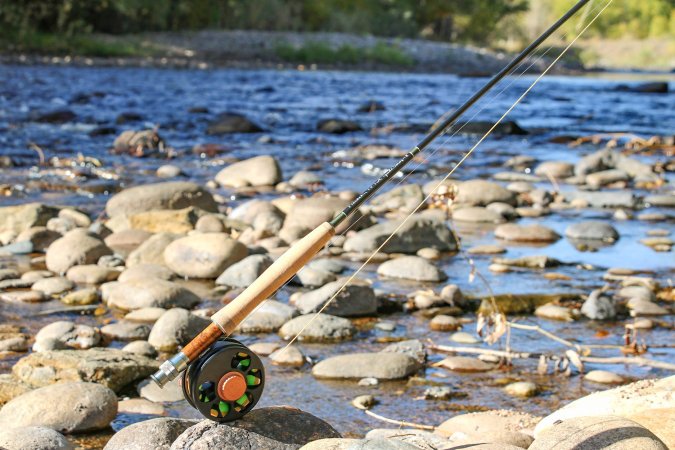
Photo by Dac Collins
Pros
- Good value
- Decent caster with plenty of backbone
Cons
- Plain looks and basic components
Report Card
- Accuracy: 5/9
- Ease of Cast: 3/5
- Max Distance: 75 feet
- Pairs Well With: Scientific Anglers Mastery MPX line
Key Features
- 9 foot long, 4-piece
- Medium action
- Reverse wells grip
- Made in Korea
- Lifetime warranty to original owner
As the most affordable mid-priced rod on the list, the Beulah Guide Series II is a utilitarian rod. It’s not going to win any beauty contests or casting competitions, but it’ll put fish in the net all day long.
I found the GS2 to be a middle-of-the-road caster. It has more of a medium action (even though it’s listed as medium-fast). It also felt a bit stouter than the other models, and I felt like it casted more like a 6wt than a 5wt.
This stoutness isn’t necessarily a bad thing. It actually made the GS2 one of my favorite rods for fishing heavier nymph rigs, and the rod got a lot of use during periods of high and dirty water. It just wasn’t my first pick for more delicate work.
The GS2 is a workhorse of a rod that excels on bigger water, and it’s a solid option for the budget-minded angler.

How to Choose a Fly Rod for Trout

When shopping for a new fly rod, it helps to have a basic understanding of rod weights, lengths, and actions. This will help you find the right tool for your needs.
A quick note on materials. Most modern fly rod blanks (the actual poles that the rod components are attached to) are made of graphite. This material has become the industry standard because it is very lightweight and has an ideal combination of strength and sensitivity. Some trout fishermen with a taste for the retro gravitate toward rods made of fiberglass and bamboo, the predecessors to graphite. Fiberglass rods can be fun to fish with, especially on smaller water, and good bamboo rods are coveted by collectors an anglers alike. For most intents and purposes, though, a new fly angler is going to be best served with a modern graphite rod.
Weights and Lengths
The “weight” of a fly rod refers to the width of the blank and the weight of the fly line it’s designed to cast. As examples, we have 1- and 2-wt rods for catching small fish in tiny streams, and 12- to 14-wt rods for chasing tarpon, marlin, and other big game. The core weights most associated with trout fishing are 3-6.
Fly rods are typically longer than the fishing rods used by conventional anglers. The most common length for fly rods, and especially trout rods, is 9 feet. Lighter weight rods are often a bit shorter (down to 7 or even 6 feet), while most heavier rods are available in longer lengths (9-and-a-half-feet and longer) for ease of casting and mending on bigger water.
The gold standard among fly rods for trout is a 9-foot, 5-weight, and this is what most fly shops would recommend to a newbie angler who wants a do-it-all trout stick. A lot of anglers who get hooked on trout fishing will then expand their quiver of rods as they learn how and where they like to fish. As examples, a lot of dry-fly purists gravitate to shorter 4 weights, while nymph- and streamer-fishermen on bigger rivers typically use longer 6-weights. Creek anglers usually favor 3-weight (or lighter) rods.
Actions
One of the most common terms used to describe a fly rod (or a conventional rod for that matter) is its “action.” In the most basic terms, a rod’s action refers to how much it bends and where. The three basic types are fast-action, slow-action, and medium-action. A lot of fly rods on this list fall somewhere in between (you’ll hear people talk about medium-fast fly rods, for example), but the basic profiles of each action are as follows.
Fast-action rods are the stiffest of the three. Only the top third of a fast-action rod bends when casting. This translates to more power and accuracy, and it helps generate high line speeds and tight loops. A trade-off is that fast-action rods are a little more difficult to cast well, especially in the hands of a beginner fly caster. That’s because it’s harder to feel a stiff rod bend, and being able to feel that bend is crucial to timing your cast.
Slow-action rods are the most flexible of the three. They bend down into the lower third and the handle of the rod when casting. This softness allows for a gentler casting stroke, and it helps present a fly delicately, which can be essential in some trout fishing scenarios. The deep bending action also makes small fish feel bigger, and the shock absorption helps protect lighter lines. The main trade-off here is a lack of power, and these rods don’t cast very well at distance or into the wind.
Medium-action rods fall somewhere in between fast and slow. The top half of the rod bends when casting, and this bend is easier to feel than a fast-action rod but not as noticeable as a slow-action rod. This makes for a versatile rod with a good blend of power and softness, and a medium-action rod is typically more forgiving in the hands of a beginner fly caster. The best medium-action rods are an ideal blend of the two. Others do everything well enough but fall short in terms of performance: they’re not quite as accurate or powerful as fast-action rods, and they’re not as delicate or tactile as slow-action rods.
Final Thoughts on the Best Fly Rods for Trout
You have plenty of options if you’re looking for one of the best fly rods for trout, but I’ve narrowed down a list of 12 rods to get you pointed in the right direction. This list includes several all-rounders, along with some specialty rods that are designed for more niche applications.
Hardcore trout anglers looking for the best performing fast-action rods need look no further than the Scott Centric, the G. Loomis NRX+, and the new Orvis Helios. Newer anglers and those on a budget should consider the Douglas DXF Gen2 or the Redington Classic Trout. If you fish a lot of creeks, check out the Douglas Upstream 6-piece models, and if you like fishing dry flies exclusively, you’ll love the Thomas & Thomas Paradigm and the Scott G.




